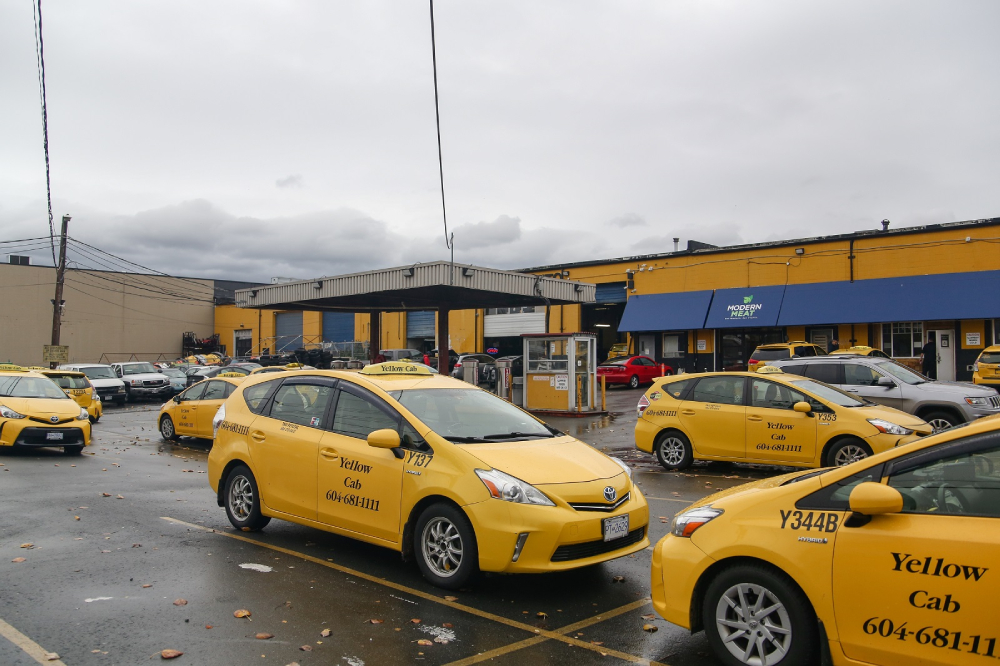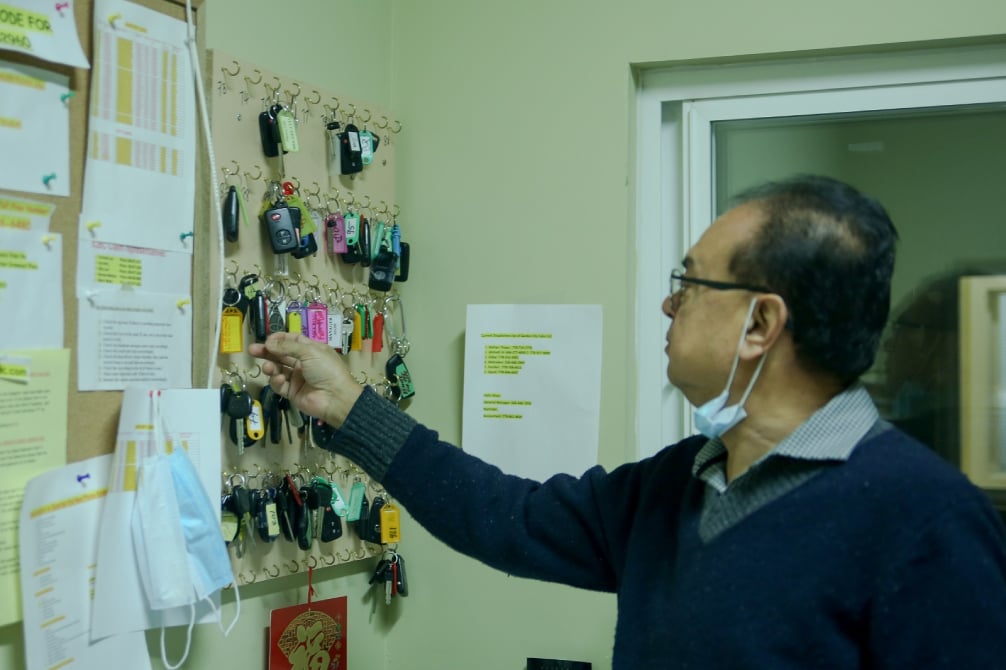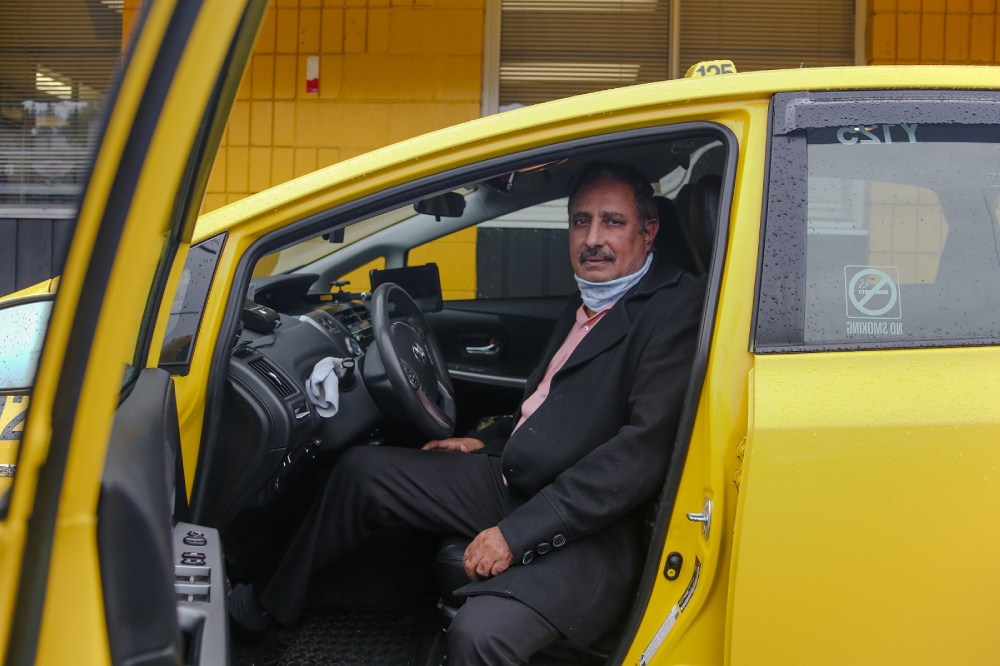“You gotta hold their hand.”
There aren’t many seniors asking for rides anymore, Kulwant Sahota has noticed. It’s dicey for them to venture into public spaces unnecessarily, and the booming delivery business has the essentials covered.
Still, there’s the occasional senior who needs to get to an appointment and calls a cab. When Sahota the taxi driver picks them up, he doesn’t let COVID-19 get in the way of serving them like he always has.
“You have no choice,” said Sahota. “When you have an elderly person, you have to help them into the car. If they have a walker, you have to touch it.”
These days, every passenger is treated to a pristine backseat, one that takes 15 minutes for drivers like Sahota to thoroughly sanitize.
In addition to his uniform of a collared shirt and black leather loafers, he wears a cloth covering over his nose and mouth, patterned with blue swirls, to protect himself and passengers. It’s made it a little harder to have the conversations he enjoys while on the job.
Sahota works for Yellow Cab, Vancouver’s largest taxi company, which in March hustled to buy protective equipment for drivers before WorkSafeBC offered any recommendations. They made do with plastic shields from Home Depot before their custom orders came in.
Also acquired were a stash of 23,000 masks and jugs of Eliminator 42, a federally-tested, pale-yellow COVID-19 disinfectant. As for the dispatching centre on Clark Drive, it armoured up with plexiglass like a medical office.
But even with the best protections for vehicles, taxi rides are not without risk.
President Mohan Kang of the BC Taxi Association has called driving during the pandemic “fighting in the dark.” He says there are only three things a driver can do: hope, pray and keep clean.
“Yes, it’s scary,” Sahota admitted. He has a new granddaughter and would love to see her more often, but he keeps his distance if he’s been driving. “You’re worried all the time, but you have to do your job.”

Sahota has seen a lot in his career as a taxi driver.
“I used to frame houses,” he said. “I ended up driving a taxi temporarily, and I just loved it. About 25 years ago in Surrey, I was one of the first Brown guys that used to work the night shift, because they were all scared to work. So I’ve been through it — I’ve been stabbed. But I love talking to people, and just stayed.”
In 2020, the big fight was supposed to be with ride-hailing.
Sahota took on Uber and Lyft at the beginning of the year, with Yellow Cab and eight others launching and losing a legal bid to stop them from operating in B.C.
But shortly after came the pandemic, which not only devastated the close-quarters work of taxi drivers but the many other sectors that supplied them passengers.
Sahota has never experienced anything like it.
“The industry’s really hurting,” said Sahota, who serves as the president of Yellow Cab, which is jointly owned by many of the company’s drivers.
Taxis once could count on a steady stream of passengers at Vancouver’s airport. But YVR’s latest count found that domestic flights are down 75 per cent compared to last year, with international flights down over 90 per cent.
“The flights that come, come half empty,” said general manager Hafiz Khan of Garden City Cabs, which is based in Richmond where the airport is.
And those who do fly into Vancouver from abroad typically make transportation arrangements ahead of time in preparation for self-isolation.
For taxi drivers hoping to pick up anyone else, it’s now up to a four-hour wait for passengers. Yellow Cab charges about $25 for an average a trip from the airport. If a driver is lucky enough to do four trips during their 12-hour shift, they make $100 before expenses.
The sad state of the hotel industry is also something to cry about, said Khan, with the tourism decline taking away the bulk of their business. Steveston, the historic Richmond fishing community and a popular attraction, is as devoid of potential passengers as YVR.
“We just keep open to keep the company intact,” said Khan. “Business-wise, it’s not working. We don’t make money. Some months we break even, some months we lose money.”
Garden City Cabs no longer bothers to keep a night shift anymore. In September, provincial health officer Dr. Bonnie Henry imposed a 10 p.m. last call for any establishment serving drinks.
“The business for the night shift has died,” said Sahota at Yellow Cab. “The restaurants are mostly takeout. Bars are closed. Nightclubs are non-existent.”
When COVID-19 hit, Yellow Cab dropped to 450 drivers from 1,500. It’s a dramatic decline not only because of the lack of passengers, but because many drivers have chosen to stay off the road to avoid COVID-19 risks.
Drivers tend to be very family oriented, said Sahota, and may be caring for or living with elderly parents. They may also be elderly themselves.
A large number of drivers are also immigrants. According to Kang at the taxi association, this is because the skillset and business model lent well to newcomers.
The industry offered a stable ladder to climb: drivers could make enough money to buy their own taxi, earning more and perhaps later transition into other work.
Khan of Garden City, for example, was a lawyer in Bangladesh before he immigrated. He opted to work in the taxi industry rather than make the challenging transition to try and practise locally.

But in these times, a taxi is worth “next to nothing,” said Sahota, who co-owns a taxi himself. The pandemic has led some drivers to ditch the industry entirely, instead driving buses or for apps.
For those taxi drivers who kept at the wheel this year, cruising the city’s arteries gave them a view of who was venturing out and what trips Vancouverites deemed essential.
Sahota drove mostly people who didn’t want to take to public transit to work: doctors, nurses, construction workers and sex workers. There were also those who wanted rides to and from medical appointments.
Drivers have a choice of which passengers they’re comfortable with picking up. But even then, the road is bumpy.
For starters, how can you really know if a passenger is in good health? “It’s simply their word when they say they’re OK,” said Kang.
But even if there’s a risk, how do you reject someone who is in need of a ride? “How do you say no to a guy who was sent to the hospital and wants to go back home?” asked Kang.
Sahota shares the story of a passenger whose request to Yellow Cab for a ride came with a warning: “I think I have COVID-19.”
The driver met the passenger anyway, who explained that he had symptoms and wanted to get a lab confirmation to see if he was positive. The destination was a drive-thru test site in the parking lot of a west side care home. The driver accepted the ride.
But when they arrived at the testing site...
“The driver lost it,” said Sahota. “He said ‘No, no, no, I can’t go any further,’ because he had to wait in the lineup. And that would’ve been more exposure for the driver.”
So the driver dropped the passenger off, drove home, dumped his clothes into the washer and jumped into the shower. (The passenger was able to get another taxi to carry him through the drive-thru.)
“There’s a lot of pressure,” said Carolyn Bauer, Yellow Cab’s general manager who tries to make sure all drivers are cared for at this time.
She knows them well, so if a complaint comes in, she’ll ask what caused them to act out of “their style.” Often, it’s stress about making ends meet.
The industry no longer offers the ladder it once did. In a pandemic, the taxi association has said that in a choice between life and livelihood, livelihood has to come second.
“But it’s a job that we do,” said Sahota on a recent Tuesday morning as he buckled up to pick up a passenger. “I enjoy doing it, and I’m going to keep on doing it.” ![]()
Read more: Local Economy, Coronavirus

















Tyee Commenting Guidelines
Comments that violate guidelines risk being deleted, and violations may result in a temporary or permanent user ban. Maintain the spirit of good conversation to stay in the discussion.
*Please note The Tyee is not a forum for spreading misinformation about COVID-19, denying its existence or minimizing its risk to public health.
Do:
Do not: